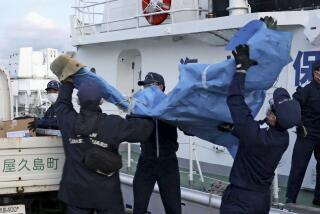U.S. Pacific Command Weathers Rough Period
- Share via
PEARL HARBOR, Hawaii — One of their spy planes is still in China. The fishing vessel accidentally sunk by one of their submarines lies 2,000 feet beneath the Pacific with bodies still inside.
They have had to boot out one of their finest officers and bury men who were supposed to be digging up the dead.
And two of their helicopters went down in their own back yard.
Shame and senseless deaths have haunted the work of the world’s farthest-reaching military command over the past few months.
Even in the best of times, the U.S. Pacific Command headquarters, on a tree-lined hilltop overlooking Pearl Harbor, is no carefree outpost.
“When you have 300,000 people, both uniformed and civilian, that represent 20 percent of all U.S. active-duty military forces in a region that includes 43 countries and nearly 60 percent of the world’s populations, it is a dynamic environment,” said Army Lt. Col. Christy Samuels, spokeswoman for the command.
But it is not friction between North and South Korea, India and Pakistan or China and Taiwan that has given the command its biggest challenges lately.
In February, the sinking of a Japanese fishing vessel off Hawaii by the USS Greeneville killed nine Japanese men and boys.
Three days later, six Army soldiers from an infantry unit based in Hawaii were killed when two Black Hawk helicopters crashed on Oahu.
Then on April 1, the 24 crew members of a U.S. spy plane began 11 days in captivity on the Chinese island of Hainan after their aircraft collided with a Chinese fighter jet.
And on April 7, a helicopter crash in Vietnam killed seven U.S. servicemen and nine Vietnamese who were searching for remains of Americans missing in action from the Vietnam War. The mission had been overseen by a task force based at Camp H.M. Smith, site of Pacific Command headquarters. Those killed included two servicemen stationed in Hawaii.
The 640 military and civilian workers at Camp Smith, and others at the Pacific Command’s Hawaii-based units, did an emotional about-face as they welcomed home the spy plane crew one day and the next day saw the return of the bodies of the seven servicemen killed in Vietnam.
The task of identifying the bodies fell to the Army Central Identification Laboratory, at Hickam Air Force Base on Oahu.
Through it all, the command has accommodated hundreds of visiting journalists and dealt with the diplomatic fallout from some of the tragedies.
The events have been a shocking reminder of the risks associated with military service. But command officers insist there has been no grumbling.
“When we experience tragedy, we pull together and help each other and we work our way through it and we keep training,” Samuels said.
As the largest of the United States’ nine unified military operations, Pacific Command has an area of responsibility that stretches north to the Arctic, east to the West Coast, south to Antarctica, and west to Madagascar, covering more than half the Earth’s surface.
It was established in 1947 as an outgrowth of the World War II command structure and later directed wars in Korea and Vietnam.
Hawaii Sen. Daniel Inouye said recent events should serve as a reminder to President Bush and others in Washington that U.S. security is tied closely to the Asia-Pacific region.
“This is where the action is. This is where the potential trouble spots are located,” he said. “Out of the 10 largest armies in the world, eight are located in the area of responsibility of CINCPAC”--Commander in Chief, Pacific--”so this is the important command.”
Even though the spy plane crew has returned home and the Pacific Fleet has concluded disciplinary proceedings against Greeneville skipper Cmdr. Scott Waddle that mean the end of his career, challenges still lie ahead.
Many in Japan, including relatives of those killed in the sinking of the Ehime Maru, are angry that Waddle will not face courts-martial and will be allowed to retire with full pension and no reduction in rank.
Meanwhile, the Navy is drawing up a plan to bring the sunken ship to shallower waters to allow divers to remove the nine bodies believed to be inside.
And the damaged EP-3E spy plane remains on Hainan Island as U.S. officials press for its return.
More to Read
Sign up for Essential California
The most important California stories and recommendations in your inbox every morning.
You may occasionally receive promotional content from the Los Angeles Times.










